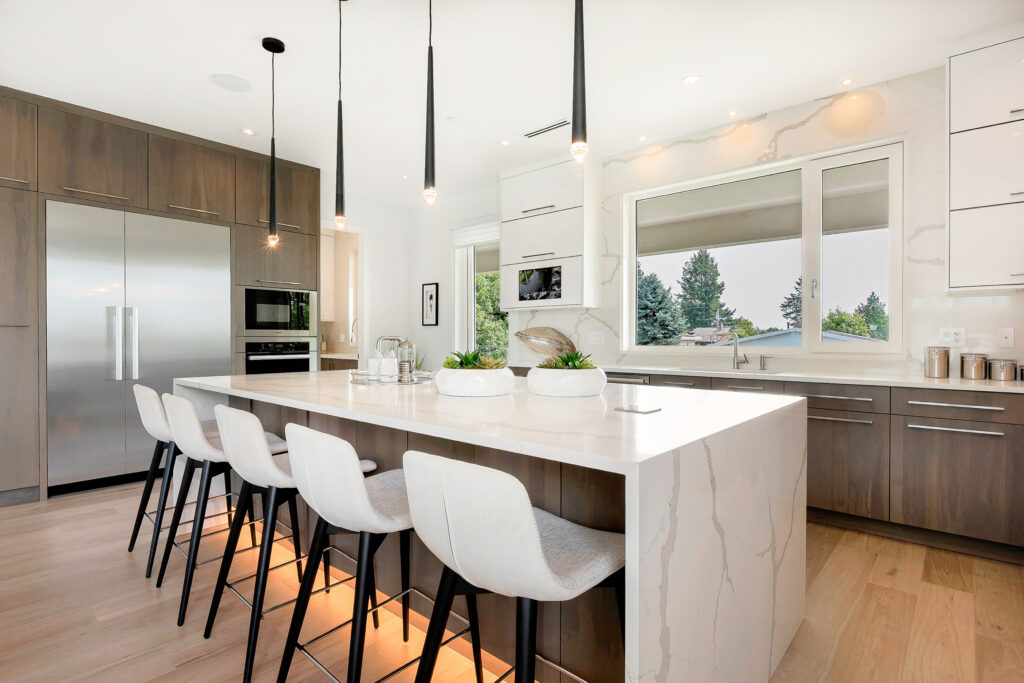Guide to Kitchen Island Seating

Thinking about adding seating to your kitchen island? Kitchen island seating has become a go-to feature in modern and open-concept homes—and for good reason. Not only does it look great, but it also adds serious function to one of the most used spaces in your house.
Whether you’re entertaining guests, helping with homework, or just grabbing a quick bite, the right island seating setup can make your kitchen feel more inviting, improve how you move through the space, and even boost your home’s resale value. Let’s break down everything you need to know to find the perfect fit for your space and style.
Table of Contents
Benefits of Kitchen Island Seating
Kitchen island seating isn’t just about having a few extra stools—it’s a game-changer for how you use your space. First off, it adds bonus dining and gathering space without needing to squeeze in a separate table. Whether you’re enjoying your morning coffee, having a quick lunch, or chatting with friends while cooking, island seating keeps everyone close and connected.
It’s also perfect for multitasking. You can help the kids with homework while prepping dinner, fold laundry while keeping an eye on a snack in the oven, or simply catch up on emails from your laptop without leaving the heart of your home.
And here’s the best part: you don’t need a full remodel to get these perks. Adding seating to your kitchen island can totally enhance the flow and function of your kitchen with minimal effort.
Types of Kitchen Island Seating
When it comes to kitchen island seating, it’s not one-size-fits-all. The style you choose can totally change the vibe of your space—and how you use it.
Here’s a breakdown of some popular options to help you figure out what works best for your kitchen.
Bar Stools vs. Counter Stools
Let’s start with the basics: height matters. Bar stools are taller (usually around 28–30 inches high) and work best with raised bar-height counters. Counter stools, on the other hand, are a bit shorter (typically 24–26 inches) and are made to pair with standard kitchen counters. It’s super important to measure your island before buying so your knees don’t end up bumping the underside every time you sit down.
Backless Stools
If you’re working with a smaller space or just want a clean, minimal look, backless stools are a solid choice. They tuck in neatly under the island, which helps keep walkways clear and the space feeling open. Just keep in mind they’re not the most comfy for long hangouts, so they’re ideal if you don’t plan on sitting for hours at a time.
Swivel Stools
Swivel stools make it easy to turn and chat with people in the kitchen, living room, or wherever the action is. They’re great for open-concept layouts and homes that love to entertain.
Bench Seating
If you’ve got a larger island, bench seating can be a fun and functional option. It’s great for families with kids or for creating a more casual, booth-like feel. Think of it as a hybrid between kitchen and dining room vibes—perfect for laid-back meals or weekend brunches.
No matter your style, there’s a seating option out there that’ll make your island even more of a hub in your home.
Ideal Seating Heights and Dimensions
Before you start shopping for stools, it’s super important to get your measurements right—because even the most stylish seating won’t work if it’s the wrong height or crammed too close together.
Standard Island Height vs. Counter/Bar Height
Most kitchen islands are designed to be counter height, which is about 36 inches tall. If your island has a raised section or a dedicated bar area, that part might be bar height—usually around 42 inches.
Why does this matter? Because you’ll need stools that match. Counter-height stools are typically 24–26 inches tall, while bar-height stools are closer to 28–30 inches.
How to Choose the Right Stool Height
Here’s an easy trick: aim for about 9 to 13 inches between the seat of the stool and the bottom of the countertop. That gives people enough legroom to sit comfortably without feeling squished.
Recommended Spacing Between Seats
You also want to make sure everyone has enough elbow room. Plan for at least 24 inches of space per stool (measured from the center of one stool to the center of the next). If the stools have arms or swivel, give them a bit more room—closer to 28–30 inches per seat is ideal.
How Many Seats Can Fit at Your Kitchen Island?
One of the most common questions homeowners have is: How many seats can I actually fit at my kitchen island? The answer depends on the size of your island and how much space each person needs to sit comfortably.
Guide Based on Island Length
Here’s a quick cheat sheet to help you figure out what your island can handle:
- 4-foot island: Usually fits 2 seats comfortably
- 6-foot island: Can fit 3 seats, sometimes 4 if they’re compact
- 8-foot island: Room for 4–5 seats, depending on stool size and spacing
- 10-foot+ island: You’re in luxury territory—5 or more seats easily!
Just keep in mind that these are general estimates. The style of your stools and whether they swivel or have arms can also affect how many you can fit.
Space Allowances Per Person
To keep everyone comfy, plan for about 24 inches of width per seat. If the stools have arms or are a bit wider, bump that up to 28–30 inches. For depth, make sure there’s at least 15 inches of countertop overhang so legs don’t feel cramped—and about 12 inches of actual seating depth. It’s also smart to leave about 36 inches of clearance behind the stools so people can move freely around them.
Examples and Visual Tips
Picture it this way: if your island is 6 feet long, divide that by 2 feet per person, and you’ve got room for three people without feeling squeezed. If your stools swivel or have backs, you might want to drop it down to two for better spacing. Want a cozy café vibe? Mix in a bench or L-shaped seating on the end.
Choosing the Right Seating Style for Your Kitchen
Once you’ve figured out how many stools you need and what height works best, it’s time for the fun part—picking a style that actually fits your kitchen vibe. Stools may seem like a small detail, but they can totally tie your space together!
Match Your Stools to Your Kitchen’s Look
Think about the overall aesthetic of your kitchen. Whatever your style, there’s a stool to match. For example, if your kitchen has clean lines and neutral tones, go for minimalist stools with metal or acrylic finishes. If it leans rustic, wooden stools with a distressed finish will feel right at home. And if your space is more eclectic, you can even mix and match styles for a collected, lived-in feel.
Consider the Materials
Stools come in all kinds of materials—wood, metal, plastic, upholstered, or a mix of everything. Each one has its pros and cons:
- Wood brings warmth and works with almost any style, but might show wear over time.
- Metal is durable and modern, great for industrial or contemporary kitchens.
- Upholstered seats add comfort, especially if you plan to sit for a while, but they might need a little more upkeep (hello, spilled juice).
- Woven or rattan options add texture and a coastal or boho feel, and they’re surprisingly comfy too.
It really comes down to how you use your island and what kind of maintenance you’re okay with.
Open vs. Tucked-In Designs
Here’s something people often overlook: how your stools sit at the island when not in use. Backless or low-back stools are perfect if you want a clean, open look because they can tuck in completely under the counter. Great for smaller kitchens or if you like things neat and out of the way. Higher-back stools offer more support and comfort, but they’ll be more visible and can make the space feel a little more “furnished.”
At the end of the day, choosing the right seating is about striking the perfect balance between style, comfort, and function.
Comfort and Ergonomics
If your kitchen island seating looks amazing but isn’t comfortable, you probably won’t use it much. Whether you’re sipping coffee, working on your laptop, or chatting over dinner, comfort matters just as much as style (maybe even more).
Footrests, Cushioning, and Back Support
Look for stools with built-in footrests so you’re not awkwardly dangling your legs or shifting around trying to get comfy.
Cushioned seats are another game-changer, especially if you’re planning to use your island for more than just a quick snack. Even a little bit of padding makes a big difference for longer hangs. High-back stools also offer more comfort than backless ones, especially for adults who spend time reading, eating, or working at the island.
When to Prioritize Function Over Form
It’s easy to fall in love with a sleek, designer stool, but ask yourself: Is this practical for my day-to-day life? If you’ve got little kids, for example, you might want something sturdy with wipeable surfaces—because spills will happen. Stools with wide bases and no sharp edges are great for safety too.
If your island doubles as a work-from-home space or a homework zone, think ergonomic. Choose seating that offers good back support and a comfy seat so no one ends up shifting around every five minutes.
You don’t have to sacrifice style for comfort—but when in doubt, go for the option that you’ll actually enjoy sitting in every day.
DIY and Custom Seating Ideas
If you’re feeling creative, there are tons of fun DIY and custom options for kitchen island seating.
Built-In Island Benches or Banquettes
Want to make your island feel more like a cozy breakfast nook? Consider building a bench or banquette on one side. It’s a great way to create a comfy, semi-permanent seating area that feels more like a dining space. Add cushions or pillows, and you’ve got the perfect spot for coffee, casual meals, or catching up with friends.
Repurposing or Refinishing Vintage Stools
Love the charm of vintage pieces? Try hitting up thrift stores, flea markets, or Facebook Marketplace for old stools you can breathe new life into. A little sanding, fresh paint, or reupholstering is a budget-friendly way to add character to your kitchen.
Creative Layouts for Small or Awkward Kitchens
If your kitchen is on the smaller side, consider using a slim bench, one or two low-profile stools, or even foldable options you can tuck away when not in use. You can also experiment with placing seating at the ends of the island instead of the side, which can work better in tighter spaces and still give you a place to sit and snack.
Kitchen Flow and Traffic Considerations
Now that you’ve picked out your dream island seating, it’s time to think about placement. Because even the best seating setup can become frustrating if it turns your kitchen into a crowded obstacle course.
Maintaining Clearance Around Islands and Walkways
A good rule of thumb is to leave at least 36 to 48 inches of space between your island seating and surrounding cabinets, walls, or appliances. This gives people plenty of room to walk by—even when someone’s seated. If your kitchen doubles as a high-traffic zone (pets, kids, or guests hanging around), that clearance becomes even more important.
Tips for Avoiding Overcrowding or Poor Layout
It might be tempting to squeeze in that one extra stool, but don’t do it if it means everyone feels cramped. It’s better to have fewer seats and a more breathable layout than to constantly bump elbows.
Also, be mindful of how stools interact with other parts of your kitchen—like your oven, dishwasher, or pantry doors. You don’t want to be moving a chair every time you need to grab a snack or unload the dishwasher.
Taking a few minutes to think through how people move through your kitchen can make a big difference in how enjoyable and functional your space really is.
Final Thoughts
Kitchen island seating might seem like a small detail, but when it’s done right, it can transform how your space looks, feels, and functions. From morning coffee to late-night snacks, it becomes one of those go-to spots everyone naturally gravitates toward.
Before you commit to a set of stools, take a little time to think about what really works for your kitchen—how much space you have, what style fits your vibe, and how you’ll actually use the seating day to day. Comfort, flow, and style all matter, and getting the balance just right makes a big difference.
Additional Kitchen Resources
- 10 Benefits of Refacing Cabinets
- Choosing the Right Kitchen Sink for Your Home
- Kitchen Remodeling Ideas on a Budget

Anna has over six years of experience in the home services and journalism industries and serves as the Content Manager at MyHomePros.com, specializing in making complex home improvement topics like HVAC, roofing, and plumbing accessible to all. With a bachelor’s degree in journalism from Auburn University, she excels in crafting localized, comprehensive guides that cater to homeowners’ unique needs. Living on both coasts of the United States has equipped her with a distinctive perspective, fueling her passion for turning any house into a cherished home through informed, personalized decision-making.








